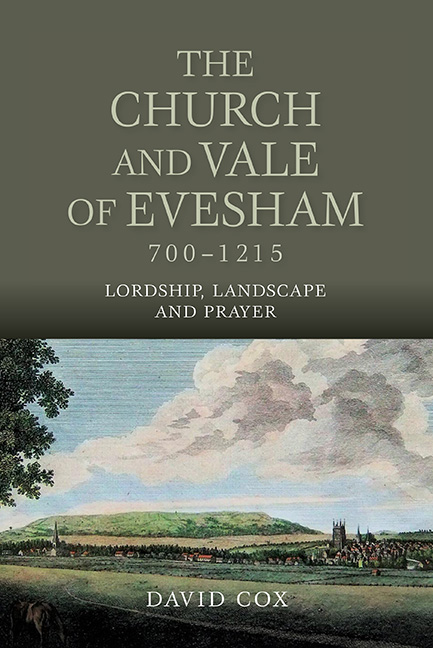Book contents
- Frontmatter
- Dedication
- Contents
- List of Illustrations
- Preface
- Timeline
- List of Abbreviations
- Part I From Minster to Abbey (701–1078)
- Part II Abbot Walter (1078–1104)
- Part III Twelfth-Century Themes (1104–1215)
- Afterword
- Appendix: The Abbots of Evesham to 1215
- Select Bibliography
- Index
- Miscellaneous Endmatter
- Frontmatter
- Dedication
- Contents
- List of Illustrations
- Preface
- Timeline
- List of Abbreviations
- Part I From Minster to Abbey (701–1078)
- Part II Abbot Walter (1078–1104)
- Part III Twelfth-Century Themes (1104–1215)
- Afterword
- Appendix: The Abbots of Evesham to 1215
- Select Bibliography
- Index
- Miscellaneous Endmatter
Summary
A profitable estate
IN the early tenth century the cares of the abbot of Evesham were considerable. He was playing a necessary part in the bishop's business and indirectly in the king’s, and at the same time he and his minster community were lords of an enviable landed estate that was indeed envied. By the 930s the minster had nearly 10,000 acres (about 4,000 hectares) of productive land on the south side of the Avon and nearly 5,000 acres on its own side of the river, where much of the landscape was wooded. The woodland too was productive; it was a source of timber, fuel, game, and honey, and of grazing for pigs. By then the church of Evesham may also have had some outlying estates, probably in the nearby wooded Arden district, and twenty miles south of Evesham in the Cotswolds, all within the territory of the Hwicce.
Not only were the minster's estates extensive but parts of them were also economically vigorous and increasingly valuable. It seems likely that a phase of warmer and dryer weather had for some time been causing the population on the south side of the river to grow and the land to be farmed more intensively. It is by postulating the growth of population and the higher productivity of the land that one may perhaps account for a pre-Conquest process that has left evidence of itself in local documents and on the modern map; that is to say, the division of early land units into smaller but still viable estates (Fig. 3). It was a process in which ‘Wycweon’ was divided to make Childswickham and Wickhamford, Bretforton was split into an Upper End and a Lower End (which were so named by c.1300), Hampton into Great and Little Hampton, Honeybourne into Church Honeybourne and Cow Honeybourne, and Littleton into North, Middle, and South Littleton. North of the river the same process seems to have taken place. The Twyford land unit was divided up before 1086 and Lenchwick, Norton, and Chadbury were then put together as the manor of Lenchwick; the Twyford stretch of the salt way became the boundary between the township of Evesham on the one hand and those of Lenchwick and Norton on the other.
- Type
- Chapter
- Information
- The Church and Vale of Evesham, 700-1215Lordship, Landscape and Prayer, pp. 42 - 49Publisher: Boydell & BrewerPrint publication year: 2015



